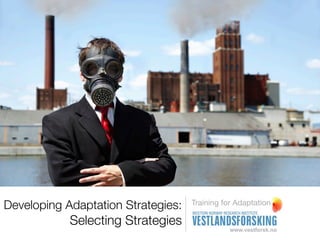
Developing adaptation strategies - Selection - training for adaptation
- 1. Developing Adaptation Strategies: Training for Adaptation Selecting Strategies
- 2. Process Stage 2 Developing Adaptation Strategies: Selection Selecting the Right Strategy This module outlines the principles for prioritising between different adaptation measures in particular -Cost-effectiveness -Precautionary principle It concludes with a list of recommended criteria for selecting the right strategy Climate Adaptation C. Aall & D.Davies 2012 Online Training Resource
- 3. Process Stage 2 Developing Adaptation Strategies: Selection Principles for Prioritising Environmental Policy Means Example principles that are frequently used -Best available technology -Polluter pays principle -Cost-effectiveness -Steering-effectiveness -Precautionary principle -Sustainable development But which of these principles can and should be used within the field of climate change adaptation? Climate Adaptation C. Aall & D.Davies 2012 Online Training Resource
- 4. Process Stage 2 Developing Adaptation Strategies: Selection Cost Effectiveness Often used in climate mitigation policy making. • Difficult to apply within climate change adaptation policymaking, because: -The benefits of climate change adaptation are multi-dimentional (whereas climate mitigation is one-dimentional; reduction in green house gas emissions) -The often very long time span for assessing possible benefits of adaptation measures (up to 50 years) results in low figures when calculating the present value of future benefits from adaptation -Lack of knowledge on probability for future changes in local climatic conditions makes it difficult to establish quantitative risk assessments • Thus we might have to manage with qualitative criteria sets for prioritising climate change adaptation measures. Climate Adaptation C. Aall & D.Davies 2012 Online Training Resource
- 5. Process Stage 2 Developing Adaptation Strategies: Selection Precautionary Principle The precautionary principle is well established in international environmental policy. • Principle 15 of the 1992 Rio Declaration on Environment and Development states: – In order to protect the environment, the precautionary approach shall be widely applied by States according to their capabilities. Where there are threats of serious or irreversible damage, lack of full scientific certainty shall not be used as a reason for postponing cost-effective measures to prevent environmental degradation. • The Commission of the European Communities stated in 2000: – The dimension of the precautionary principle goes beyond the problems associated with a short- or medium-term approach to risks. It also concerns the longer run and the well being of future generations. – Whether or not to invoke the precautionary principle is a decision exercised where scientific information is insufficient, inconclusive or uncertain and where there are indications that the possible effects on the environment or human, animal and plant health may be potentially dangerous and inconsistent with the chosen level of protection. • One implication of the precautionary principle is shifting the burden of proof to the new activities of technologies. Climate Adaptation C. Aall & D.Davies 2012 Online Training Resource
- 6. Process Stage 2 Developing Adaptation Strategies: Selection Adaptation and the Precautionary Principle As societal changes have been featured into the vulnerability analysis advocated by this training programme, the precautionary principle is especially worth highlighting. • The relevance of the precautionary principle in adaptation to climate change is to avoid new risks possibilities as a consequence of adaptation strategies or measures. • The precautionary principle is criticised by some as potentially impeding innovation and development by shifting the burden of proof, such that any activity must prove that it does not cause harm. – According to this view a risk assessment based on probabilities derived from available but often imperfect evidence is sufficient. – A stronger version of the precautionary principle would suggest that risk assessments should be based to a great extent of the potential to cause harm rather than on knowledge of actual harm. Climate Adaptation C. Aall & D.Davies 2012 Online Training Resource
- 7. Process Stage 2 Developing Adaptation Strategies: Selection Final key points Selecting the right strategy - Recommended criteria 1) Adapt to the climate of today 2) Establish sufficient institutional capacity for implementing climate adaptation measures 3) Carry out climate vulnerability analyses 4) Inform the public about local vulnerability and adaptation challenges 5) Consider whether a ’wait-and-see’ attitude is sensible before implementing further measures 6) Make strategic prior to operational work 7) Cause-oriented measures should be carried out before effect-oriented measures 8) Give priority to ’no-regret measures’ (measures that are sensible regardless of climate scenarios) 9) Climate adaptation must not lead to considerably higher emissions of greenhouse gases 10) Climate adaptation must not be in conflict with the overall goal of sustainable development Climate Adaptation D.Davies 2012 Online Training Resource
Notas do Editor
- \n
- \n
- \n
- \n
- \n
- \n
- \n
